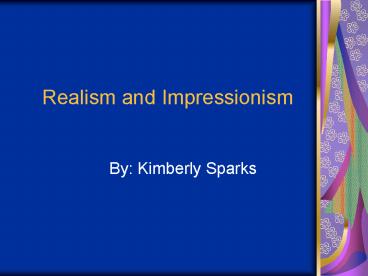Realism and Impressionism PowerPoint PPT Presentation
1 / 17
Title: Realism and Impressionism
1
Realism and Impressionism
- By Kimberly Sparks
2
Realism
- Business and Industry continue to undergo a
technical and industrial revolution. - Nationalism arises
- Science continues to grow
- Philosophy and psychology influence the arts
3
Immigration
- Between the 18th and 19th centuries 70 million
people immigrated to North America. - These people came from
- Europe, Ireland, France, Italy, Germany
- and Scandinavia
- Europeans literally populated the globe by the
end of the 19th century
4
Business and Industry
- Industry changed from production based on coal
and iron to being based on electricity, internal
combustion engines, and chemistry. - U.S. share of industrial output climbed from
23-36 percent. - By the end of the 19th century, Germany became
the 2nd largest industrial producer due to
industrialization and railroads. - By 1913, Europe and N. America represented 82 of
the worlds industrial production.
5
Business and Industry Cont.
- Corporations started and the decision-making was
placed in the hands of salaried executives. - Marketing networks were created.
- Market place increased with business now centered
around new products and new technologies. - Examples Automobiles, bicycles, cinema, and
later the airplane
6
Workers and Socialism
- Growth of the working class
- 1864-1893 Powerful movements and mass strikes
- International Working Men Association (IWMA) and
the Socialist International were formed. - Political parties and trade unions emerged
- Before WWI expansions of labor and socialist
movements occurred.
7
Workers and Socialist Cont.
- 2nd International Organization was created and
socialist in nature. - Strikes were their weapon.
- By the beginning of the 19th century, the labor
was impotent because of the rise of Nationalism
and Imperialism which was centered around the
German Reich.
8
German Reich
- Germany remained a series of independent states
under individual rule. - Had 25 states, and 3 city-states joined to create
a unified German Reich with William I. - Authoritarian state whose government was not
responsible to the parliament. - Powerful Military
- Secularization which attacked Catholics, expelled
Jesuits, and controlled the Roman clergy - Anti-Socialist laws
- Germany became the 2nd most powerful nation on
earth. - Triple Alliance formed
9
Science
- Model of the atom showed the movements of
electrons - Discoveries of X-Rays, superconductivity, and the
spectroscopy gaseous matter. - Genetics formed
- Bacteriology began
- Philosophy and psychology also began
10
Realism in the Arts
- Dont glorify the past
- Seeks the truth
- Beauty in the commonplace
- Focus on conditions of the working class
- Represents everyday scenes
11
Artists
- Gustave Courbet- Unprejudiced of customs, ideas,
and appearance of the French Society. The Stone
Breakers - Edouard Manet- Responsible for bridging the gap
between realism and impressionism - Rosa Bonheur- Portrayed animals, well known and
respected was the first women to become an
officer in the Legion of Honor - Jean-Francois Millet- Barbizon School painted
the honest simple life of peasants
12
Realism in Theatre
- Dramatic literature strove for truthful portrayal
- Everyday life where the playwright was directly
familiar and was the subject matter. - Artists
- Henrik Ibsen- Problem dramas, careful details,
and dealt with moral and social issues - George Shaw- Devoted to socialism, faith in
humanity, many people feel he ranks among the
greatest playwrights such as Shakespeare - Tennesse Williams- Blended qualities of realism
with scenic structural or symbolic devices. - Arthur Miller- First to include homosexual
characters.
13
Impressionism
- Realist begin looking for spontaneity, harmonious
colors and subjects from the everyday. - Camera was discovered
- Artists had to compete with the camera because
people no longer wanted to buy paintings when
they could take a picture. - Painters began emphasizing the presence of color
within shadows, therefore making an impression
on the retina. - In its truest form Impressionism only lasted 15
years, but profoundly influenced all paintings
that followed. - Painting out doors influenced the effects of
natural light on objects and atmosphere. - Subjects painted were landscapes, rivers,
streets, cafes, theatres, and etc.
14
Artists
- Claude Monet- Modern life, recorded everyday
themes with objective observations, optical
truth painting reflected innocent joy in the
world in a positive view. - Mary Cassatt- Women and Children were her
favorite subjects, brushwork is less obvious. - Auguste Rodin- Centurys most remarkable
sculptor, lots of idealism and social comment,
sculptures have irregularities that shimmer in
the light.
15
Post-Impressionism
- Similar to Impressionist
- Gave their subject matter a complex and personal
significance - Concerned with capturing a sensory experience.
- Philosophy of art for the arts sake
- Rarely sold their work
- Interested as painting as a flat surface composed
of shapes, lines and colors, which became the
foundation of this movement. - Return to form and structure in painting
16
Vincent Van Gogh
- Vincent Van Gogh-Intensely emotional in pursing
form, gives us one of the most personal and
subjective artistic viewpoints in the history of
Western art. - Starry Night
17
Impressionism and Music
- Free use of chromatic tones and key shifts
- Traditional major/minor tonality
- New atonal harmonic expression began
- Musicians
- Claude Debussy- sought to capture the shimmering
light effects in music used similarities of
painters - Maurice Ravel- traditionalist, followed classical
structures, use of symbolism, and known for his
orchestra music - Both used rich harmonies, new scales, and were
interested in the exotic

